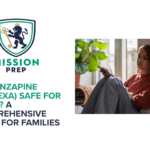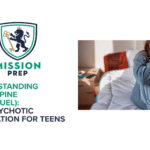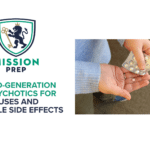Restlessness in Teens: Causes & Support Options for School Behavior Problems

Everyone feels restless or fidgety at times. Occasional fidgeting may result from something as simple as drinking too much caffeine in the morning or feeling apprehensive about an upcoming exam.
However, if restlessness in teens routinely interferes with their ability to concentrate or achieve in school, it may indicate an underlying mental health issue. For instance, anxiety, ADHD, or chronic stress may lead to excessive fidgeting. Conditions such as these can worsen without treatment, so early intervention can help teens feel more balanced, in control, and capable of focusing in school.
Professional teen mental health care can help you get to the root of the problem and figure out the most appropriate avenues for treatment. This page can also help you better understand restlessness in teens by covering:
- Signs and consequences of restlessness in teens
- Common causes of restlessness in teens
- Risks of persistent restlessness and fidgeting
- Coping strategies for the classroom
- Effective treatment options for restlessness in teens
If fidgeting in the classroom is getting you into trouble in school, this article is for you.

Signs and Consequences of Restlessness in Teens
Many adolescents struggle to sit still in the classroom as a result of an underlying mental health problem. This may be because they’re attempting to cope with pent-up energy or nerves or trying to self-soothe.
Common signs of restlessness in teens include:
- Frequent moving
- Tapping on the desk
- Tapping a foot
- Clicking a pen
- Shifting in chairs
- Leaving seats frequently
- Excessively adjusting materials on a desk, such as pens or paper
Although fidgeting may be a way of releasing pent-up energy, it can be disruptive to teachers and other students. As a result, chronic restlessness in teens can lead to a host of negative consequences at school. A few ways that teen restlessness affects students in the school setting may include the following.
Negative Impact on the Teacher-Student Relationship
Extensive research shows that a positive teacher-student relationship is essential for learning to occur.1 Unfortunately, teachers can become frustrated by a student’s frequent fidgeting. This may lead to tension between the teacher, who needs to maintain classroom order, and the student, who feels misunderstood and unable to correct their behavior.
Negative Impact on Academic Performance
Constant restlessness and fidgeting can cause a student to miss important information or instructions, which may directly impact academic performance. Additionally, many teens with restlessness or hyperactivity find school to be a stressful experience.2 They can feel unable to meet the demands of a classroom environment, as it feels impossible to sit still or refrain from speaking out of turn.6 This negative perception of school can lead students to “check out”, impacting academic performance.
Negative Impact on Peer Relationships
Peers may find a student’s frequent movements to be bothersome or distracting. Peers may also pick up on a teacher’s frustration over a student’s restlessness and develop a negative view of the student or label them a “trouble-maker.”6
Disciplinary Action
Restlessness in teens is often accompanied by impulsivity. Therefore, hyperactive students are frequently disciplined in school for disruptive motor behavior or speaking out of turn.3
Causes of Fidgeting in Teens in the School Setting
Several factors can lead to difficulty sitting still. For example, teens who are short on sleep, nervous, or experiencing high levels of stress may struggle to remain motionless in class. Therefore, if you’re often fidgety in the classroom, you may want to consider whether you are well-rested and adequately managing stress.
However, if you feel restless after tending to sleep and stress levels, you could be facing something worth paying attention to, like anxiety or ADHD. Anxiety and ADHD are both prevalent among teens, and both are treatable with professional care. We take a look at the link between these conditions and restlessness below.
Anxiety and Restlessness:
Research shows that around 32% of adolescents have an anxiety disorder.4 However, on many occasions, anxiety is undiagnosed and untreated in teens. This is partly because signs and symptoms of anxiety overlap with other disorders.
Some common symptoms of generalized anxiety disorder include:4
- Inattention
- Outbursts
- Irritability
- Difficulty focusing
- Restlessness
Restlessness may actually be one of the most common physical signs of anxiety teenagers display. Plus, if you worry often and experience stomachaches along with your restlessness, anxiety may be contributing to your fidgeting.
ADHD and Restlessness:
ADHD is one of the most common mental health disorders in youth, affecting around 5.6% of teens.2 It is classified as a neurodevelopmental disorder, and along with trouble sitting still, ADHD teens may struggle with inattention and impulsivity.
Further, while many people have heard of ADHD, they might not know that there are three types of this disorder. These include:
- Inattentive ADHD: Characterized by difficulty with focusing, staying on task, and remembering things
- Hyperactive/Impulsive ADHD: Involving fidgeting, restlessness, trouble sitting still, and speaking out of turn.
- Combined type ADHD: Occurs when a person experiences both inattentiveness and hyperactivity
Risks of Untreated Anxiety and ADHD
Treating teen anxiety and ADHD is not just important for making school life easier. Treatment is essential for a teen’s present and future well-being. Untreated teen anxiety is associated with substance misuse, unemployment, and mental health challenges, including depression.6
Untreated ADHD may also put teens at risk for a number of different outcomes. For example, studies show that untreated ADHD is linked with a heightened risk of substance abuse, car accidents, various criminal actions, and other risky behaviors.2 Additionally, teens with ADHD are also more likely to lose touch with friends and family.2
For these reasons, early intervention for teen anxiety and ADHD is typically imperative for getting them the support they require for moving forward in balanced and regulated ways.
Steps to Take for Restlessness in Teens
If you are trying your best to sit still in the classroom setting but can’t seem to overcome your need to move and fidget, try not to blame yourself. In conditions like ADHD, the need for movement comes directly from the brain. In fact, studies suggest that in ADHD, fidgeting is actually often necessary for the brain to be able to pay attention.7
Still, because of the potential negative consequences of excessive movement in the classroom, it is recommended to seek professional help to gain control of your restlessness.
The first thing you may wish to do is set up a comprehensive evaluation to determine what’s making it so difficult for you to keep your body still in school. Your parent or caregiver may be able to help you access this evaluation through your primary care doctor.
This evaluation is important as restlessness and fidgeting in teens can be symptoms of multiple conditions, for which treatment is often necessary to improve well-being. For example, ADHD and anxiety are often accompanied by symptoms like fidgeting. The good news is that these conditions are treatable.
The following are some helpful steps you can take if restlessness is impacting you.
1. Set Up a Comprehensive Evaluation With a Mental Health Provider:
As mentioned, fidgeting can be a sign of several mental health problems. A trained mental health provider is the right person to accurately determine what is causing the uncontrollable need to fidget. Further, an accurate diagnosis can lead to appropriate treatment options so you can get relief and enjoy improvements in relationships and academics.
2. Seek Parent and Teacher Support:
For fidgety teenagers, help from parents and teachers can be valuable. Let your parents and teachers know that you find it difficult to control your restlessness. Explain that you are trying, and ask for their support.
Your parents and teachers will likely be asked questions as part of your evaluation. So letting them know about your struggle can open the conversation for making a plan to reduce the negative consequences of your fidgeting. For example, your teacher may give you permission to try out some coping strategies that help many students with ADHD in the classroom.
3. Learn About Coping Strategies:
While you wait for the results of your evaluation, you can take steps to learn about coping strategies that may help. Three low-risk coping skills restless teens could try in the classroom include keeping a stress ball, using a fidget spinner, or sitting on a wobble stool. In fact, many studies support using tools like these. Since fidgeting may be necessary for focusing in students with ADHD, using fidget toys may satisfy the brain’s need without causing disruption to the class or teacher.
Treatment Options for Restless Teens
You don’t have to suffer the negative consequences of fidgeting and restlessness on your own. Treatment options exist that could help you. Once you have completed a comprehensive evaluation with a mental health professional, you may receive a diagnosis such as ADHD. At this point, you and your mental health care provider can come up with a plan to reduce the negative impact of your condition.
Treatment for ADHD teens may include a combination of approaches like psychoeducation, medication, school accommodations, and behavioral interventions.3
Psychoeducation involves training you and your loved ones about your condition and its symptoms, and may include written instructions to support you. When appropriate, stimulant medications, a well-established part of ADHD treatment, may be prescribed.
Further, school accommodations ADHD teens often benefit from include the creation of an individualized educational plan (IEP). This is a formal plan designed to reduce the academic impact of your symptoms. For example, with an IEP in place, you may be permitted to take small breaks to move during the school day.
Finally, talk therapy may be appropriate if mental health conditions such as anxiety are present. For instance, cognitive behavioral therapy is an evidence-based modality for targeting the maladaptive beliefs and thoughts that may contribute to restlessness in teens.

Mission Prep: Professional Support for Restless Teens
Fighting restlessness on your own can be an exhausting and frustrating experience. It may also be discouraging to face social, academic, or disciplinary consequences when you know that you are trying your best to sit still in the classroom.
At Mission Prep, we understand what you are going through and are here to help. Our outpatient program for teens includes a team of professionals who specialize in teen mental health care, including anxiety and ADHD.
When you call our office, we can set up an ADHD evaluation for teens to determine why it seems impossible to stay still. After listening carefully to your experience and completing a thorough evaluation, we can develop goals and a treatment plan to support you. At Mission Prep, we care about your happiness and want to help you thrive. Contact our team today if you’re ready to get started.
References
1.Fabio, R. A., Mento, C., Gangemi, A., & Picciotto, G. (2023). ADHD symptoms increase perception of classroom entropy and impact teacher stress levels. Children, 10(6), 1082. https://doi.org/10.3390/children10061082
2. Sadr-Salek, S., Costa, A. P., & Steffgen, G. (2023). Psychological Treatments for Hyperactivity and Impulsivity in Children with ADHD: A Narrative Review. Children, 10(10), 1613. https://doi.org/10.3390/children10101613
3. Villodas, M. T., Pfiffner, L. J., & McBurnett, K. (2012). Prevention of serious conduct problems in youth with attention deficit/hyperactivity disorder. Expert Review of Neurotherapeutics, 12(10), 1253–1263. https://doi.org/10.1586/ern.12.119
4. Chiu, A., Falk, A., & Walkup, J. T. (2016). Anxiety disorders among children and adolescents. FOCUS the Journal of Lifelong Learning in Psychiatry, 14(1), 26–33. https://doi.org/10.1176/appi.focus.20150029
5. Staff, A. I., Oosterlaan, J., Van Der Oord, S., Van Den Hoofdakker, B. J., & Luman, M. (2023). The relation between classroom setting and ADHD behavior in children with ADHD compared to typically developing peers. Journal of Attention Disorders, 27(9), 939–950. https://doi.org/10.1177/10870547231167522
6. Morales-Muñoz, I., Mallikarjun, P. K., Chandan, J. S., Thayakaran, R., Upthegrove, R., & Marwaha, S. (2023). Impact of anxiety and depression across childhood and adolescence on adverse outcomes in young adulthood: a UK birth cohort study. The British Journal of Psychiatry, 222(5), 212–220. https://doi.org/10.1192/bjp.2023.23
7. Son, H. M., Calub, C. A., Fan, B., Dixon, J. F., Rezaei, S., Borden, J., Schweitzer, J. B., & Liu, X. (2024). A quantitative analysis of fidgeting in ADHD and its relation to performance and sustained attention on a cognitive task. Frontiers in Psychiatry, 15, 1394096. https://doi.org/10.3389/fpsyt.2024.1394096



















